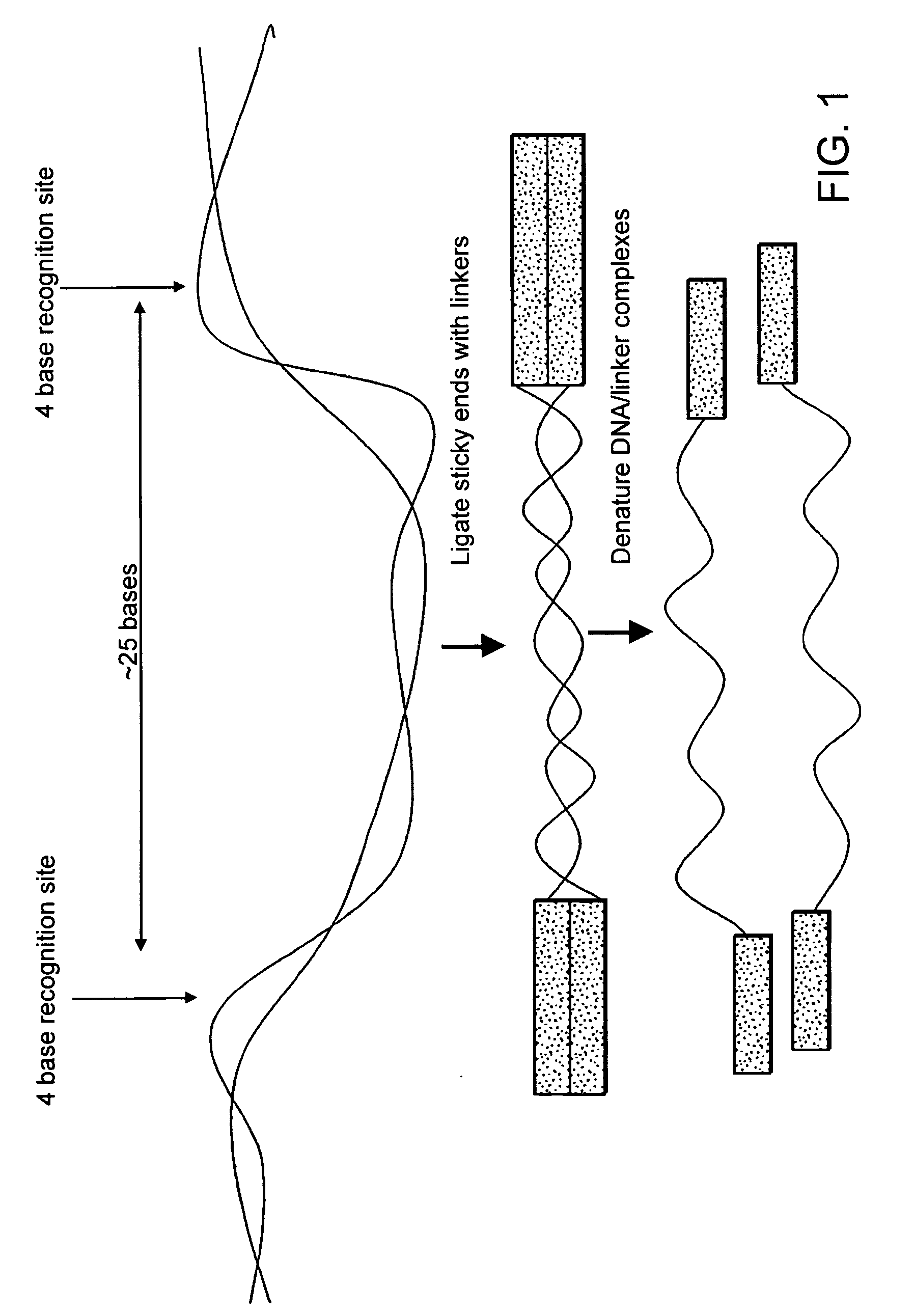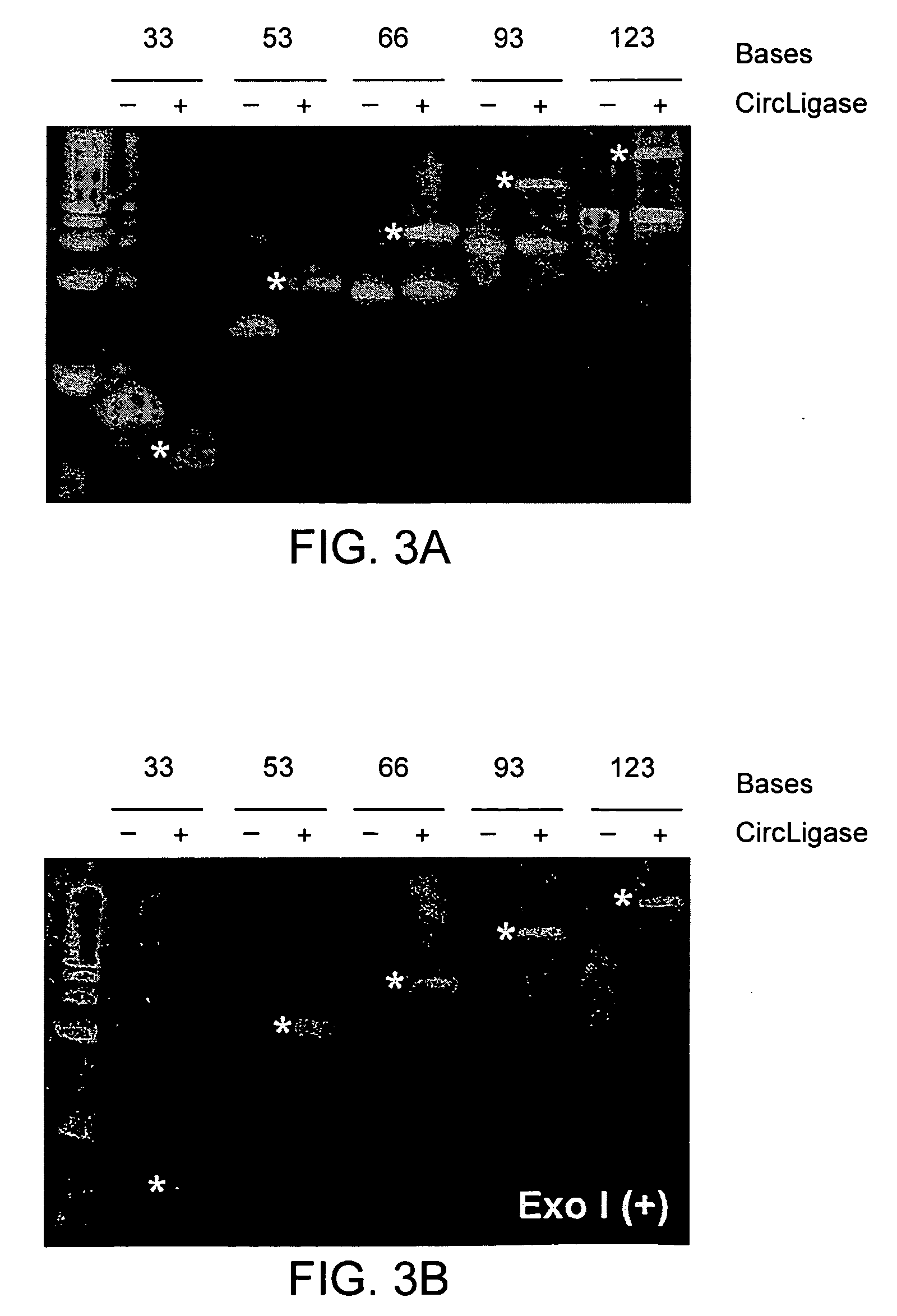Methods for nucleic acid amplification and sequence determination
- Summary
- Abstract
- Description
- Claims
- Application Information
AI Technical Summary
Benefits of technology
Problems solved by technology
Method used
Image
Examples
example 1
Creation of Anchored Amplicons Using Rolling Circle Amplification
[0070] The creation of an anchored amplicon from a linear nucleic acid template using rolling circle amplification involves (i) a circularization reaction in which the 5′ and 3′ ends of a linear nucleic acid template are ligated to form a circular nucleic acid template; (ii) a hybridization reaction in which a primer is hybridized to a single stranded circular template to create a circular template-primer hybrid; and (iii) an extension reaction in which the primer is extended by rolling circle amplification. The primer may contain one member of a binding pair that can bind to a binding partner that is attached to a solid support.
[0071] Briefly, a nucleic acid template is obtained from a cell or tissue, for example, using one of a variety of procedures for extracting nucleic acids, which are well known in the art. While the invention is exemplified below with synthetic oligonucleotides, the invention is not so limite...
example 2
Sequencing an Amplicon
[0086] This example demonstrates a method according to the invention in which a single nucleotide in a position in a nucleic acid molecule is identified. At least one sequencing primer is bound to an amplicon. The sequence of the primer in this example complementary to the 3′ linker binding site on the anchored primer, or, in effect, identical to at least a portion of the 3′ linker sequence. Alternatively, if linkers are not used, the primer may be complementary to any region of the circular template, preferably the 3′ end. The amplicon / primer complex is exposed first to a labeled nucleotide and then to an unlabeled nucleotide of the same type under conditions of, and in the presence of, reagents that allow template-dependent primer extension (FIG. 6). The signals of the labeled amplicons are then detected (FIG. 7).
Cycle Sequencing of Rolling Circle Products Bound to Streptavidin Tubes
[0087] After the primer bound rolling circle amplification described in ...
example 3
Analysis of Single Molecule Sequencing
[0090] Using a TIR Optical Setup such as that diagrammed in FIG. 9, images of a surface on which single molecule sequencing of an attached rolling circle amplified template has been performed are then analyzed for primer-incorporated U-Cy5. Typically, eight exposures of 0.5 seconds each are taken in each field of view in order to compensate for possible intermittency (e.g., blinking) in fluorophore emission. Software is employed to analyze the locations and intensities of fluorescence objects in the intensified charge-coupled device pictures. Fluorescent images acquired in the WinView32 interface (Roper Scientific, Princeton, N.J.) are analyzed using ImagePro Plus software (Media Cybernetics, Silver Springs, Md.). Essentially, the software is programmed to perform spot-finding in a predefined image field using user-defined size and intensity filters. The program then assigns grid coordinates to each identified spot, and normalizes the intensit...
PUM
| Property | Measurement | Unit |
|---|---|---|
| Concentration | aaaaa | aaaaa |
| Fluorescence | aaaaa | aaaaa |
Abstract
Description
Claims
Application Information
 Login to View More
Login to View More - Generate Ideas
- Intellectual Property
- Life Sciences
- Materials
- Tech Scout
- Unparalleled Data Quality
- Higher Quality Content
- 60% Fewer Hallucinations
Browse by: Latest US Patents, China's latest patents, Technical Efficacy Thesaurus, Application Domain, Technology Topic, Popular Technical Reports.
© 2025 PatSnap. All rights reserved.Legal|Privacy policy|Modern Slavery Act Transparency Statement|Sitemap|About US| Contact US: help@patsnap.com



